INTL 706 - Evaluating Global Business Strategies of Etihad & Emirates
VerifiedAdded on 2023/06/12
|7
|1228
|315
Report
AI Summary
This report provides a comprehensive evaluation of the global business strategies employed by Etihad Airways and Emirates Airlines, two major players in the UAE's aviation industry. It begins by defining global business strategy and outlining the business ventures of both airlines. A critical analysis of their respective strategies follows, highlighting differences in product offerings, fleet size, and customer relationship management. The report then offers recommendations for both companies, including the implementation of low-cost leadership, the incorporation of core competencies, and the formation of strategic alliances. The conclusion emphasizes the importance of globalization in modern business and reiterates the report's objective of providing informative insights into the global business strategies of Etihad Airways and Emirates Airlines. This resource is available on Desklib, where students can find a wealth of solved assignments and past papers.
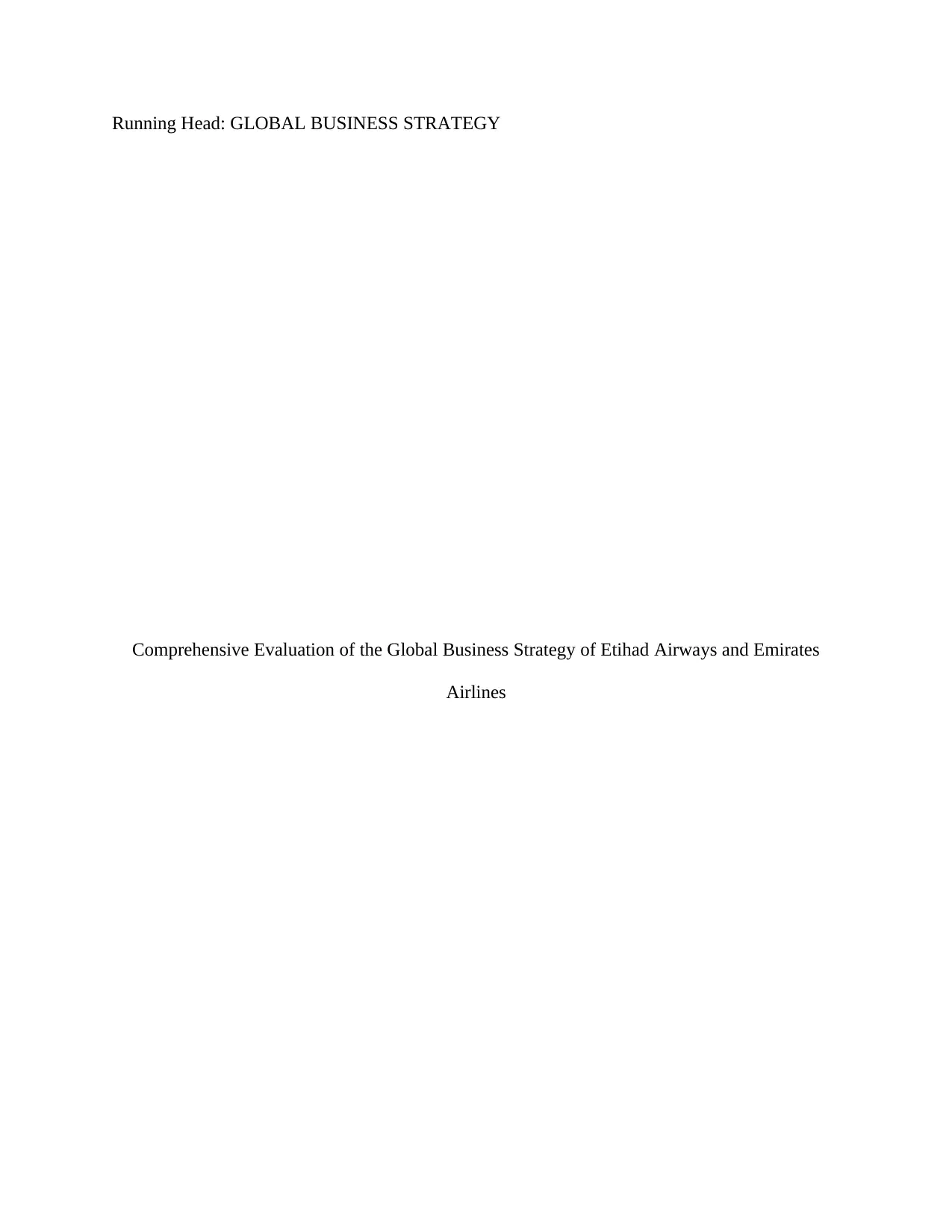
Running Head: GLOBAL BUSINESS STRATEGY
Comprehensive Evaluation of the Global Business Strategy of Etihad Airways and Emirates
Airlines
Comprehensive Evaluation of the Global Business Strategy of Etihad Airways and Emirates
Airlines
Paraphrase This Document
Need a fresh take? Get an instant paraphrase of this document with our AI Paraphraser
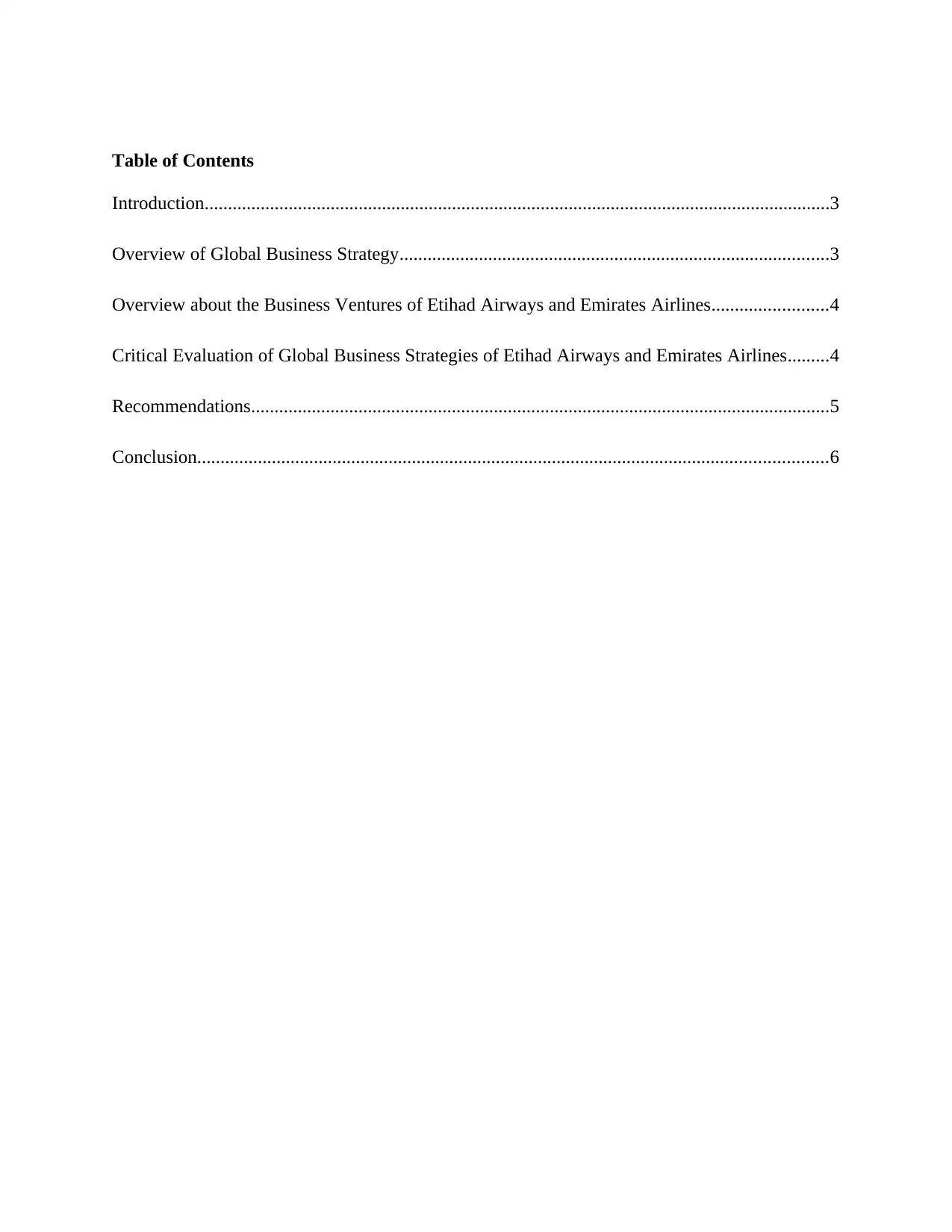
Table of Contents
Introduction......................................................................................................................................3
Overview of Global Business Strategy............................................................................................3
Overview about the Business Ventures of Etihad Airways and Emirates Airlines.........................4
Critical Evaluation of Global Business Strategies of Etihad Airways and Emirates Airlines.........4
Recommendations............................................................................................................................5
Conclusion.......................................................................................................................................6
Introduction......................................................................................................................................3
Overview of Global Business Strategy............................................................................................3
Overview about the Business Ventures of Etihad Airways and Emirates Airlines.........................4
Critical Evaluation of Global Business Strategies of Etihad Airways and Emirates Airlines.........4
Recommendations............................................................................................................................5
Conclusion.......................................................................................................................................6
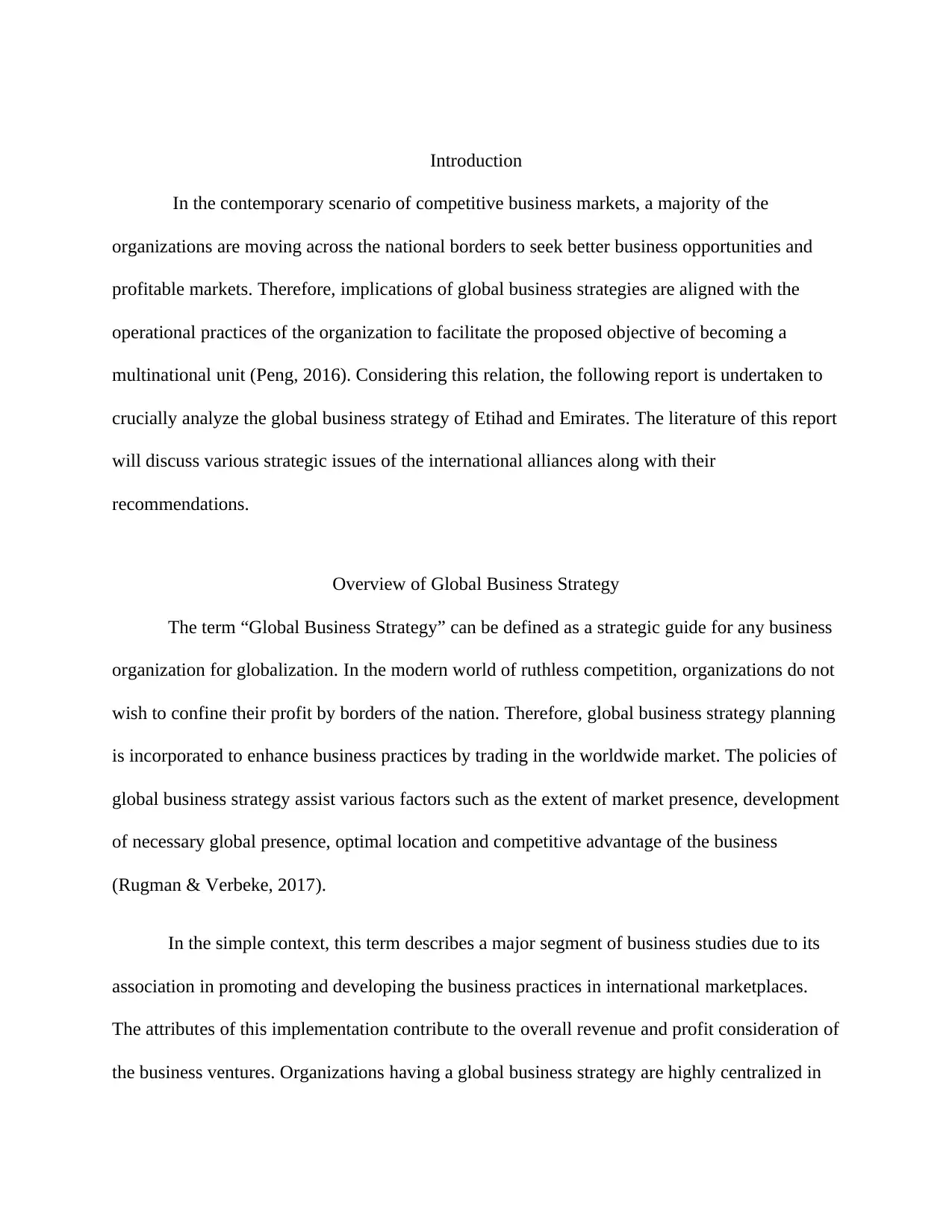
Introduction
In the contemporary scenario of competitive business markets, a majority of the
organizations are moving across the national borders to seek better business opportunities and
profitable markets. Therefore, implications of global business strategies are aligned with the
operational practices of the organization to facilitate the proposed objective of becoming a
multinational unit (Peng, 2016). Considering this relation, the following report is undertaken to
crucially analyze the global business strategy of Etihad and Emirates. The literature of this report
will discuss various strategic issues of the international alliances along with their
recommendations.
Overview of Global Business Strategy
The term “Global Business Strategy” can be defined as a strategic guide for any business
organization for globalization. In the modern world of ruthless competition, organizations do not
wish to confine their profit by borders of the nation. Therefore, global business strategy planning
is incorporated to enhance business practices by trading in the worldwide market. The policies of
global business strategy assist various factors such as the extent of market presence, development
of necessary global presence, optimal location and competitive advantage of the business
(Rugman & Verbeke, 2017).
In the simple context, this term describes a major segment of business studies due to its
association in promoting and developing the business practices in international marketplaces.
The attributes of this implementation contribute to the overall revenue and profit consideration of
the business ventures. Organizations having a global business strategy are highly centralized in
In the contemporary scenario of competitive business markets, a majority of the
organizations are moving across the national borders to seek better business opportunities and
profitable markets. Therefore, implications of global business strategies are aligned with the
operational practices of the organization to facilitate the proposed objective of becoming a
multinational unit (Peng, 2016). Considering this relation, the following report is undertaken to
crucially analyze the global business strategy of Etihad and Emirates. The literature of this report
will discuss various strategic issues of the international alliances along with their
recommendations.
Overview of Global Business Strategy
The term “Global Business Strategy” can be defined as a strategic guide for any business
organization for globalization. In the modern world of ruthless competition, organizations do not
wish to confine their profit by borders of the nation. Therefore, global business strategy planning
is incorporated to enhance business practices by trading in the worldwide market. The policies of
global business strategy assist various factors such as the extent of market presence, development
of necessary global presence, optimal location and competitive advantage of the business
(Rugman & Verbeke, 2017).
In the simple context, this term describes a major segment of business studies due to its
association in promoting and developing the business practices in international marketplaces.
The attributes of this implementation contribute to the overall revenue and profit consideration of
the business ventures. Organizations having a global business strategy are highly centralized in
⊘ This is a preview!⊘
Do you want full access?
Subscribe today to unlock all pages.

Trusted by 1+ million students worldwide
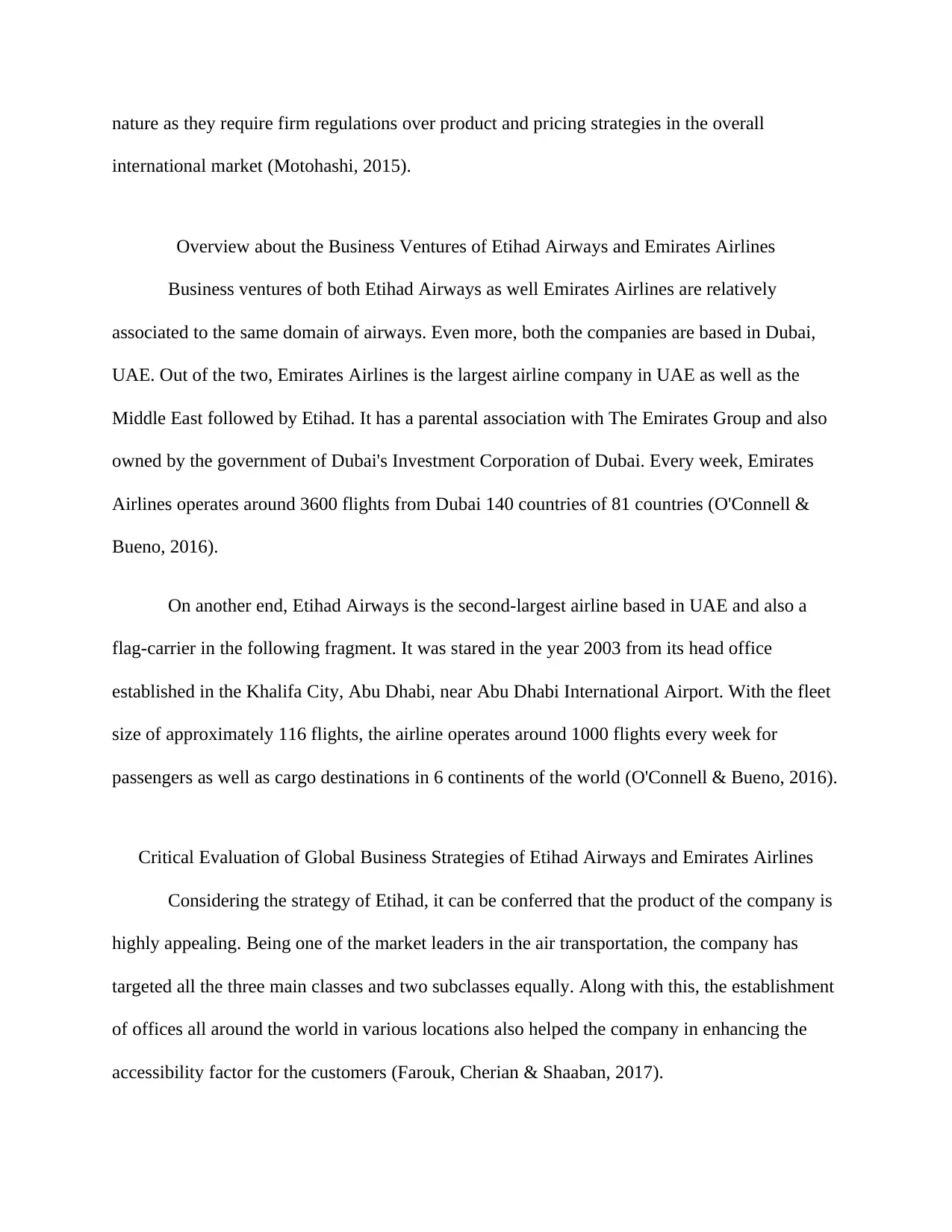
nature as they require firm regulations over product and pricing strategies in the overall
international market (Motohashi, 2015).
Overview about the Business Ventures of Etihad Airways and Emirates Airlines
Business ventures of both Etihad Airways as well Emirates Airlines are relatively
associated to the same domain of airways. Even more, both the companies are based in Dubai,
UAE. Out of the two, Emirates Airlines is the largest airline company in UAE as well as the
Middle East followed by Etihad. It has a parental association with The Emirates Group and also
owned by the government of Dubai's Investment Corporation of Dubai. Every week, Emirates
Airlines operates around 3600 flights from Dubai 140 countries of 81 countries (O'Connell &
Bueno, 2016).
On another end, Etihad Airways is the second-largest airline based in UAE and also a
flag-carrier in the following fragment. It was stared in the year 2003 from its head office
established in the Khalifa City, Abu Dhabi, near Abu Dhabi International Airport. With the fleet
size of approximately 116 flights, the airline operates around 1000 flights every week for
passengers as well as cargo destinations in 6 continents of the world (O'Connell & Bueno, 2016).
Critical Evaluation of Global Business Strategies of Etihad Airways and Emirates Airlines
Considering the strategy of Etihad, it can be conferred that the product of the company is
highly appealing. Being one of the market leaders in the air transportation, the company has
targeted all the three main classes and two subclasses equally. Along with this, the establishment
of offices all around the world in various locations also helped the company in enhancing the
accessibility factor for the customers (Farouk, Cherian & Shaaban, 2017).
international market (Motohashi, 2015).
Overview about the Business Ventures of Etihad Airways and Emirates Airlines
Business ventures of both Etihad Airways as well Emirates Airlines are relatively
associated to the same domain of airways. Even more, both the companies are based in Dubai,
UAE. Out of the two, Emirates Airlines is the largest airline company in UAE as well as the
Middle East followed by Etihad. It has a parental association with The Emirates Group and also
owned by the government of Dubai's Investment Corporation of Dubai. Every week, Emirates
Airlines operates around 3600 flights from Dubai 140 countries of 81 countries (O'Connell &
Bueno, 2016).
On another end, Etihad Airways is the second-largest airline based in UAE and also a
flag-carrier in the following fragment. It was stared in the year 2003 from its head office
established in the Khalifa City, Abu Dhabi, near Abu Dhabi International Airport. With the fleet
size of approximately 116 flights, the airline operates around 1000 flights every week for
passengers as well as cargo destinations in 6 continents of the world (O'Connell & Bueno, 2016).
Critical Evaluation of Global Business Strategies of Etihad Airways and Emirates Airlines
Considering the strategy of Etihad, it can be conferred that the product of the company is
highly appealing. Being one of the market leaders in the air transportation, the company has
targeted all the three main classes and two subclasses equally. Along with this, the establishment
of offices all around the world in various locations also helped the company in enhancing the
accessibility factor for the customers (Farouk, Cherian & Shaaban, 2017).
Paraphrase This Document
Need a fresh take? Get an instant paraphrase of this document with our AI Paraphraser
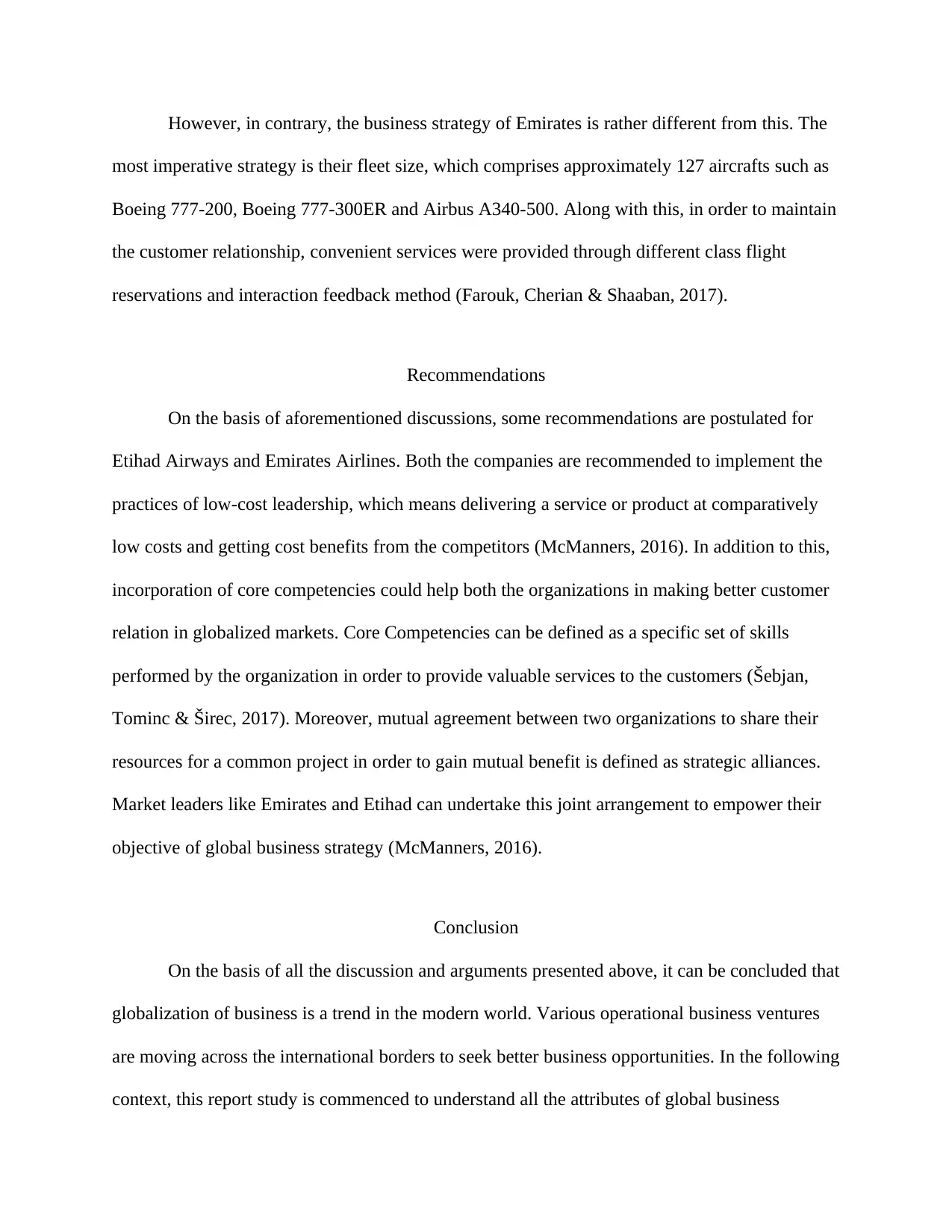
However, in contrary, the business strategy of Emirates is rather different from this. The
most imperative strategy is their fleet size, which comprises approximately 127 aircrafts such as
Boeing 777-200, Boeing 777-300ER and Airbus A340-500. Along with this, in order to maintain
the customer relationship, convenient services were provided through different class flight
reservations and interaction feedback method (Farouk, Cherian & Shaaban, 2017).
Recommendations
On the basis of aforementioned discussions, some recommendations are postulated for
Etihad Airways and Emirates Airlines. Both the companies are recommended to implement the
practices of low-cost leadership, which means delivering a service or product at comparatively
low costs and getting cost benefits from the competitors (McManners, 2016). In addition to this,
incorporation of core competencies could help both the organizations in making better customer
relation in globalized markets. Core Competencies can be defined as a specific set of skills
performed by the organization in order to provide valuable services to the customers (Šebjan,
Tominc & Širec, 2017). Moreover, mutual agreement between two organizations to share their
resources for a common project in order to gain mutual benefit is defined as strategic alliances.
Market leaders like Emirates and Etihad can undertake this joint arrangement to empower their
objective of global business strategy (McManners, 2016).
Conclusion
On the basis of all the discussion and arguments presented above, it can be concluded that
globalization of business is a trend in the modern world. Various operational business ventures
are moving across the international borders to seek better business opportunities. In the following
context, this report study is commenced to understand all the attributes of global business
most imperative strategy is their fleet size, which comprises approximately 127 aircrafts such as
Boeing 777-200, Boeing 777-300ER and Airbus A340-500. Along with this, in order to maintain
the customer relationship, convenient services were provided through different class flight
reservations and interaction feedback method (Farouk, Cherian & Shaaban, 2017).
Recommendations
On the basis of aforementioned discussions, some recommendations are postulated for
Etihad Airways and Emirates Airlines. Both the companies are recommended to implement the
practices of low-cost leadership, which means delivering a service or product at comparatively
low costs and getting cost benefits from the competitors (McManners, 2016). In addition to this,
incorporation of core competencies could help both the organizations in making better customer
relation in globalized markets. Core Competencies can be defined as a specific set of skills
performed by the organization in order to provide valuable services to the customers (Šebjan,
Tominc & Širec, 2017). Moreover, mutual agreement between two organizations to share their
resources for a common project in order to gain mutual benefit is defined as strategic alliances.
Market leaders like Emirates and Etihad can undertake this joint arrangement to empower their
objective of global business strategy (McManners, 2016).
Conclusion
On the basis of all the discussion and arguments presented above, it can be concluded that
globalization of business is a trend in the modern world. Various operational business ventures
are moving across the international borders to seek better business opportunities. In the following
context, this report study is commenced to understand all the attributes of global business
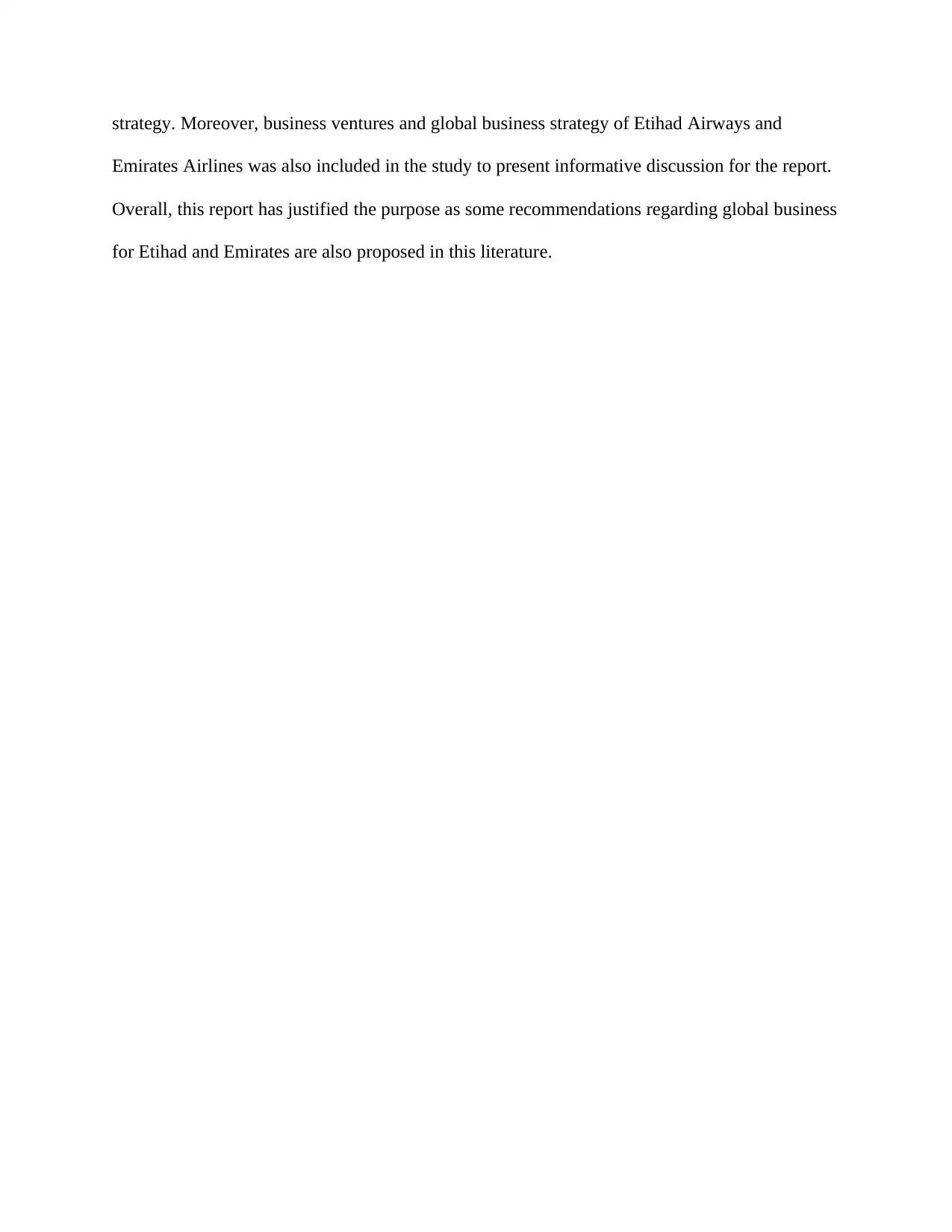
strategy. Moreover, business ventures and global business strategy of Etihad Airways and
Emirates Airlines was also included in the study to present informative discussion for the report.
Overall, this report has justified the purpose as some recommendations regarding global business
for Etihad and Emirates are also proposed in this literature.
Emirates Airlines was also included in the study to present informative discussion for the report.
Overall, this report has justified the purpose as some recommendations regarding global business
for Etihad and Emirates are also proposed in this literature.
⊘ This is a preview!⊘
Do you want full access?
Subscribe today to unlock all pages.

Trusted by 1+ million students worldwide
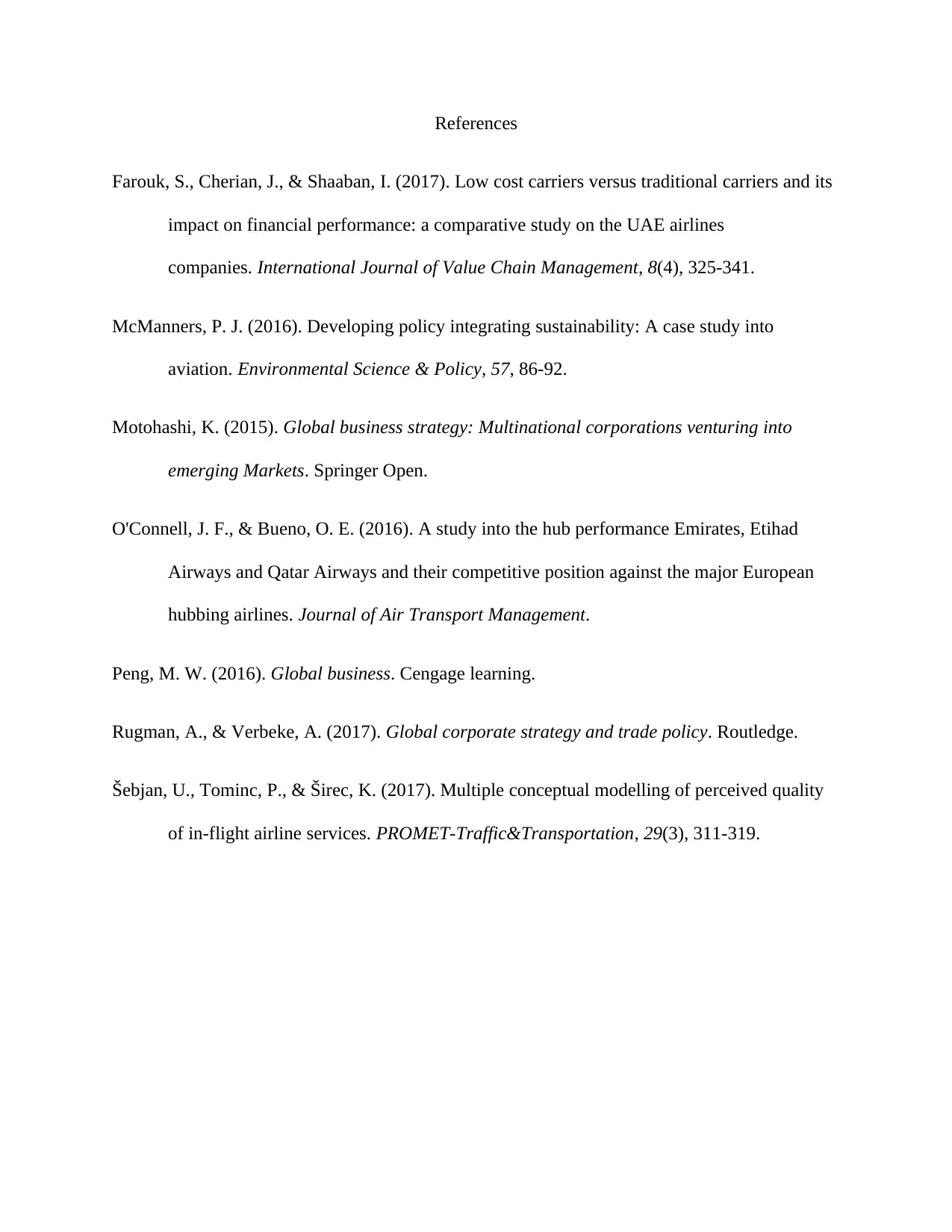
References
Farouk, S., Cherian, J., & Shaaban, I. (2017). Low cost carriers versus traditional carriers and its
impact on financial performance: a comparative study on the UAE airlines
companies. International Journal of Value Chain Management, 8(4), 325-341.
McManners, P. J. (2016). Developing policy integrating sustainability: A case study into
aviation. Environmental Science & Policy, 57, 86-92.
Motohashi, K. (2015). Global business strategy: Multinational corporations venturing into
emerging Markets. Springer Open.
O'Connell, J. F., & Bueno, O. E. (2016). A study into the hub performance Emirates, Etihad
Airways and Qatar Airways and their competitive position against the major European
hubbing airlines. Journal of Air Transport Management.
Peng, M. W. (2016). Global business. Cengage learning.
Rugman, A., & Verbeke, A. (2017). Global corporate strategy and trade policy. Routledge.
Šebjan, U., Tominc, P., & Širec, K. (2017). Multiple conceptual modelling of perceived quality
of in-flight airline services. PROMET-Traffic&Transportation, 29(3), 311-319.
Farouk, S., Cherian, J., & Shaaban, I. (2017). Low cost carriers versus traditional carriers and its
impact on financial performance: a comparative study on the UAE airlines
companies. International Journal of Value Chain Management, 8(4), 325-341.
McManners, P. J. (2016). Developing policy integrating sustainability: A case study into
aviation. Environmental Science & Policy, 57, 86-92.
Motohashi, K. (2015). Global business strategy: Multinational corporations venturing into
emerging Markets. Springer Open.
O'Connell, J. F., & Bueno, O. E. (2016). A study into the hub performance Emirates, Etihad
Airways and Qatar Airways and their competitive position against the major European
hubbing airlines. Journal of Air Transport Management.
Peng, M. W. (2016). Global business. Cengage learning.
Rugman, A., & Verbeke, A. (2017). Global corporate strategy and trade policy. Routledge.
Šebjan, U., Tominc, P., & Širec, K. (2017). Multiple conceptual modelling of perceived quality
of in-flight airline services. PROMET-Traffic&Transportation, 29(3), 311-319.
1 out of 7
Related Documents
Your All-in-One AI-Powered Toolkit for Academic Success.
+13062052269
info@desklib.com
Available 24*7 on WhatsApp / Email
![[object Object]](/_next/static/media/star-bottom.7253800d.svg)
Unlock your academic potential
Copyright © 2020–2025 A2Z Services. All Rights Reserved. Developed and managed by ZUCOL.




